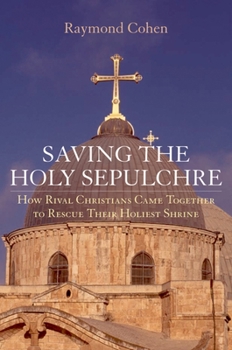Saving the Holy Sepulchre: How Rival Christians Came Together to Rescue Their Holiest Shrine
The Church of the Holy Sepulchre is the mother of all the churches, erected on the spot where Jesus Christ was crucified and rose from the dead and where every Christian was born. In 1927, Jerusalem was struck by a powerful earthquake, and for decades this venerable structure stood perilously close to collapse. In Saving the Holy Sepulchre, Raymond Cohen tells the engaging story of how three major Christian traditions--Greek Orthodox, Roman Catholic, and Armenian Orthodox--each with jealously guarded claims to the church, struggled to restore one of the great shrines of civilization. It almost didn't happen. For centuries the communities had lived together in an atmosphere of tension and mistrust based on differences of theology, language, and culture--differences so sharp that fistfights were not uncommon. And the project of restoration became embroiled in interchurch disputes and great power politics. Cohen shows how the repair of the dilapidated basilica was the result of unprecedented cooperation among the three churches. It was tortuous at times--one French monk involved in the restoration exclaimed: "I can't take any more of it. Latins--Armenians--Greeks--it is too much. I am bent over double." But thanks to the dedicated efforts of a cast of kings, popes, patriarchs, governors, monks, and architects, the deadlock was eventually broken on the eve of Pope Paul VI's historic pilgrimage to the Holy Land in 1964. Today, the Church of the Holy Sepulchre is in better shape than it has been for five hundred years. Light and space have returned to its ancient halls, and its walls and pillars stand sound and true. Saving the Holy Sepulchre is the riveting story of how Christians put aside centuries of division to make this dream a reality.
Format:Hardcover
Language:English
ISBN:0195189663
ISBN13:9780195189667
Release Date:March 2008
Publisher:Oxford University Press, USA
Length:320 Pages
Weight:1.54 lbs.
Dimensions:1.2" x 6.4" x 9.6"
Customer Reviews
1 rating
A Lesson in Renovation and in Human Nature
Published by Thriftbooks.com User , 15 years ago
For about sixteen centuries there has been an ongoing building project in Jerusalem. It is at the supposed location of Calvary and Jesus's tomb, which in between the time of the Gospels and the Emperor Constantine was originally a holy site dedicated to the goddess Venus. Constantine put a Christian basilica there, but as you can imagine, there were plenty of changes thereafter. "This is the only church in the world where first-century Herodian, second-century Hadrianic, fourth-century Constantinian, eleventh-century Byzantine, twelfth-century Crusader, nineteenth century neo-Byzantine, and twentieth-century modern masonry are visible in one place." This description of architectural history is from _Saving the Holy Sepulchre: How Rival Christians Came Together to Rescue Their Holiest Shrine_ (Oxford University Press) by Raymond Cohen. Not only does the architecture come in many different styles, but this is also "the only church in the world where six of the most ancient Christian denominations worship side by side." The minor communities, the Coptic, Ethiopian, and Syrian Orthodox churches have rights of usage of the site, but the major communities, the Greek Orthodox, Roman Catholic, and Armenian Orthodox not only have rights of usage but rights of possession of portions of the building. With but one church building over this sacred site, and many church groups that view the site as sacred, sometimes worshiping at the site has been difficult, and conflicts have been even bloody. Then in the twentieth century there was the very real risk that blocks of the church, or even its entirety, might start falling on the heads of those within. Cohen's book is a meticulous documentation of how some very disputatious devout people came to eventual agreements on keeping the building together. Problems of maintenance go back to ancient Turkish law; if you repair or cover a structure, you own it. This resulted in a hall-of-mirrors renovation policy: each sect was eager to pony up the money for repairing the structure, declining aid from any of the others; but the others would have no such thing, and so the building deteriorated. This was especially apparent after a 1927 earthquake which damaged main walls of the structure, allowing in weather to accelerate wear and tear. There was a later fire that weakened the main dome over the building. The monks and clerics might have agreed that the building was crumbling, but could come to no agreement about who was to make things better. These were factions that squabbled viciously over which of them might be allowed to clean a certain step, or where an icon might be hung. It took some bullying from the ruler of Jordan in the middle of the twentieth century to get the restoration started; he told church officials that Status Quo or not, he was going to do the work himself if no one else would. The work would have been difficult even if everyone was cooperating. The main task of stabilizing the Rotun





